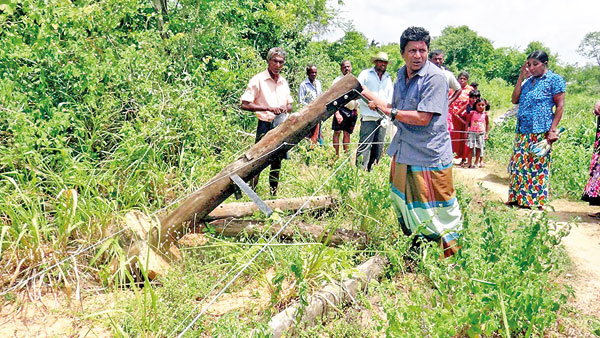News
Millions poured into jungle to save elephants, and still they die
The wildlife department spends a colossal Rs. 300 million a year on electric fences to save elephant and human lives but constant political interference and poor siting of fences are thwarting the strategy, former Wildlife Department director-general Sumith Pilapitiya said.

A house damaged by an elephant attack in Seruwila. Pic by Ishanka Sunimal
Dr. Pilapitiya, who himself had been involved in human-elephant conflict solutions during his tenure, said most fences had been built for the wrong reasons and thus in the wrong locations.
“Around 65 per cent of these electric fences have been installed to partition the land belonging to the forestry and the wildlife departments. What must be done is to create an ecological partition that would separate the humans and the elephants,” he explained.
As well, Dr. Pilapitiya charged, politicians constantly interfere, trying to change the boundaries of electric fence-demarcated areas in order to win votes from people wanting to settle in those areas.
“If elephants could vote, politicians would have to be very careful about interfering over locations of electric fences,” he remarked.
Dr. Pilapitiya cites maintenance as another reason for the failure of such projects, pointing out that simple factors can foil elaborate mechanisms.
“Wires in the fence become faulty if a piece of vegetation grows over them,” he said. Electric fences were the most effective deterrent to human-elephant conflict but were not the solution, he emphasised.
Environmental lawyer Jagath Gunawardena objects to the term coined for this issue.
“This is not a ‘human-elephant conflict’: this is an issue pertaining to the degradation and destruction of the environment,” he said.
Mr. Gunawardena said the problem could be resolved by identifying and restoring the habitats of the elephants, which have been destroyed. These habitats must be equipped with sufficient resources such as food and water to help elephants remain in such areas and not roam into villages.
The lawyer accuses officers who propose seemingly wide-ranging approaches to the problem of always ending up with a narrow perspective, blaming the elephants for roaming into villages – villages that have been set up in areas that were once the habitat of elephants.
Conservation specialist Dr. Prithviraj Fernando rejects the notion of relying on the Wildlife Department alone to solve the problem.
“There are only 1,000 wildlife officials out of nearly 1.2 million public service officers who should extend their cooperation in this regard,” Dr. Fernando, Chairman of the Centre for Conservation and Research, pointed out.
Dr. Fernando said the wildlife department had confused its role by engaging in activities such as setting up fences to protect people whereas its duty was to protect wildlife.
“This issue can be resolved by adopting a national plan that revolves around stakeholder participation and the managing of elephants in their habitats itself,” the conservation body chairman proposed.
The wildlife department says about Rs. 300 million is spent every year on installing electric fences – with results that, more often than not, fail to meet expectations.
The death of a mason in Mahiyangana due to an elephant attack last Sunday was an example of the many deaths that have been recorded as a result of human-elephant conflict.
The wildlife department wants people to take more responsibility for their behaviour to avoid being attacked by elephants.
“The home ranges of elephants have been seriously disturbed and their habitats have been reduced and fragmented,” the department’s Director-General, Chandana Sooriyabandara, said, calling on the public to avoid encroaching or trespassing into such lands to avoid being attacked by elephants.
Mr. Sooriyabandara noted that land routes through areas which were once habitats of elephants have created harm to both elephants and humans.
He dismissed claims of fences being installed in unsuitable locations.
“Around 90 per cent of the electric fences have been placed in strategic locations,” he said, explaining that a strategic location refers to the outermost circle of land area belonging to the forestry and wildlife departments.
The remaining 10 per cent of fences have been installed to prevent elephants from entering into villages, he said, noting that enormous manpower was required to ensure the fences and other programmes worked satisfactorily.
People should take lessons from the circumstances of previous elephant attacks, he said. Elephant attacks mostly occur between from 5.30 to 8.30 in the mornings or evenings. Deaths could be prevented if people took the precaution of not venturing into areas prone to elephant attacks during these periods, Mr. Sooriyabandara said.

Most fences had been built for the wrong reasons and thus in the wrong locations, say wildlife experts

